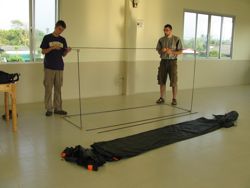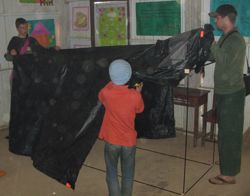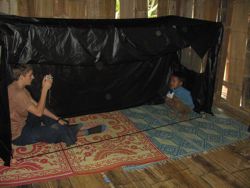Alaska Blind Child Discovery
Portable Photoscreen Tent
Home

ABCD History
Tent Photoscreening is a valid form of vision screening that reduces false positive images and un-interpretable images. Young children, especially in busy, brightly illuminated environments like schools, gymnasiums, cafeterias, health clinics can easily be distracted. They might briefly look at the screening photographer, but then glance at the parent or other children just when the flash is taken. A tent helps control ILLUMINATION and DISTRACTION.
ABCD has generated several photoscreening tents initially with 4-foot sections of PVC pipe and thick, dark cloth. An ULTRA-PORTABLE photoscreen tent was developed for Vision screening projects in Burma and in the Koyukon region. The carbon fiber poles from Fibraplex form a 96 inch x 48 inch x 32 inch rectangular shape over which black, light-weight coated nylon tent cloth is draped. At the patient-end of the tent, a flap can be opened revealing mosquitoe netting; the autofocus ADBC cameras focus better on the child's siloette. Most ADBC cameras yield good images when exposed 6 feet to 8 feet from the subject.
Figures to the right: Top: Brent Byers and Andrew Arnold erect 16 inch sections of Fibraplex tent frame vision screening Agape Home AIDS orphans in Chiang Mai, Thailand. Middle: Nylon tent draped over frame in LehTungKu Village on Thai-Burma border. Bottom: Andrew Arnold uses Canon TX1 ADBC technique in Karen State Burma IDP Village EeThooThe.
Kids Eye Disorders
Amblyopia
Vision Screening
Issues
ABCD Clinics
References
Contact ABCD


